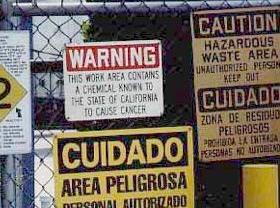|
School Children Inhale Toxics Daily,
Senate Told
By J.J. Smith
WASHINGTON, DC, October 1, 2002 (ENS) - A prominent
U.S. senator supports establishing a federal regulation
setting standards for the indoor air quality of schools, while
a activist who has been leading environmental causes for more
than two decades wants increased funding so schools districts
can test sites for toxics before construction.

Senator Hillary Clinton (Photo courtesy Office of
the Senator)
Senator Hillary Clinton, a New York
Democrat, told an official from the Environmental Protection
Agency (EPA), as well as others testifying at a hearing today
before the Senate Environment and Public Works Committee, that
the agency should establish indoor air quality standards for
schools.
Indoor air quality standards for schools are necessary to
require removal of toxics including mold and dust in order to
reduce asthma and other health problems among school children,
according to Clinton, who is a member of the committee.
Air quality has been a problem in New York schools where
the September 11 terrorist attacks on the World Trade Center
sent dust and toxic particles all over New York City.
"This needs to be fixed. We don't need to wait for another
disaster," Clinton said.
Attending the hearing, Jenna Orkin represented the
Concerned Stuyvesant Community Association, which supports
Stuyvesant High School, a New York City Ground Zero school
which was evacuated on September 11 and re-occupied in early
October. It has been continuously infiltrated by fumes,
caustic dusts, lead, and asbestos from the World Trade Center
fires and debris operations.
The National Institute of Occupational Safety and Health
found health effects in 60 percent of the 300 plus employees
who returned to Stuyvesant High School, but the agency was not
authorized to study effects on the 3,000 students.
EPA official Ramona Trovato said that while "protecting our
children's health is a priority" for the agency, the "EPA does
not have the authority to set standards for indoor
environments."
The agency can monitor the air quality of buildings, but
the EPA has never studied the air quality of schools, she told
the committee.

Families who fought a contaminated school in southeast Los
Angeles with waste hauling truck in the background
(Photo courtesy Communities for A Better
Environment)
School children may be exposed to
many other contaminants including chemicals in cleaning
products and art supplies, materials and furnishings used in
school buildings, fumes from idling school buses, pesticides,
radon and potentially even mishandled sources of mercury and
asbestos, according to Trovato.
Despite that list of contaminants, Trovato said "budget
shortfalls" at the federal and local levels have resulted in
inadequate maintainance in older schools "leading to a host of
environmental problems that can have dramatic impacts on
children, staff, learning, and the fiscal bottom line."
About 25 percent of schools report needing extensive repair
or replacement of one or more buildings, and about 11 million
children attend classes in those buildings, she said.
Environmentalist Lois Gibbs told the committee that while
those millions of children are exposed to contaminants daily,
there are no consistent guidelines for preventing the
construction of a school near a toxic waste dump, or some
other environmental hazard.

Signs near Tweedy Elementary School near Santa, Monica,
California (Photo courtesy CBE)
"While laws
compel children to attend school, there are, astoundingly, no
guidelines or laws in place that compel school districts to
locate school buildings on property that will protect the
school population from environmental health and safety risks,"
said Gibbs. Only California has some regulations and an
assessment process for the building of new schools, she told
the committee.
Gibbs became known nationally from 1979 for her fight to
get the federal government to pay to move families out of the
contaminated Love Canal section of Niagara Falls, New York.
She now serves as executive director of the Center for Health
Environment and Justice (CHEJ), a grassroots community
organization based in Falls Church, Virginia.

Lois Gibbs (Photo courtesy Colgate University Dept. of Environmental
Studies)
Gibbs told the committee that a study
of schools in five states by CHEJ researchers found that 1,185
schools are located within half a mile of a known toxic site.
The study of schools in California, Massachusetts,
Michigan, New Jersey and New York found more than 620,000
students are enrolled at those 1,185 schools, Gibbs said.
"Based on the report's findings, we believe there is a
critical need for national laws ensuring that the locations
for new schools are safe, and that, if contaminated property
is considered, it is properly cleaned up," Gibbs said.
The center has developed model legislation that urges
establishing a "school siting committee" whose job it is to
recommend sites for building new schools or the expansion of
existing schools.
The federal government should provide funding so that
school districts can have potential construction sites tested
for toxins. "In order for schools to assess property [for
toxics], it costs money. The more economically depressed an
area, the more likely it will build on a [waste] dump," Gibbs
said.

Three Detroit area school children (Photo courtesy State Environmental Resource
Center)
Senator Clinton supports increased
funding saying the money should be included in the Special
Education Reauthorization Act, which funds programs for
developmentally handicapped students.
A program that allocates funds so school districts can
determine if a potential construction site is contaminated,
"would prevent problems that cause learning disabilities,"
Clinton said.
"From one-quarter, to one-half of one percent of the
construction budget" would fund a site assessment for toxics,
testified Alex Wilson, an expert on environmentally sound
schools.
Based on its survey, the CHEJ estimates that by 2003 school
districts across the United States propose to build 2,400 new
schools.
Backed by parents from across the country, many of whom
appeared at the hearing, Claire Barnett, founder and executive
director of Healthy Schools Network urged the committe
to back funds and reforms to improve the schools.
"Asthma is the leading cause of school absenteeism due to
chronic illness, while schools are overcrowded and
unventilated, bugs nest in broken walls, toxic cleaning
supplies have provoked some school rashes," she said.
"We all see a crisis caused by the collision of trend lines
- more students, more school decay, more students with asthma,
learning and behavior disorders, and autism spending more
hours at school daily," said Barnett. "School environments are
densely occupied indoor environments. This issue is at the
center of how we live and how we educate the next generation."
Copyright Environment News Service (ENS) 2002. All Rights
Reserved.
|